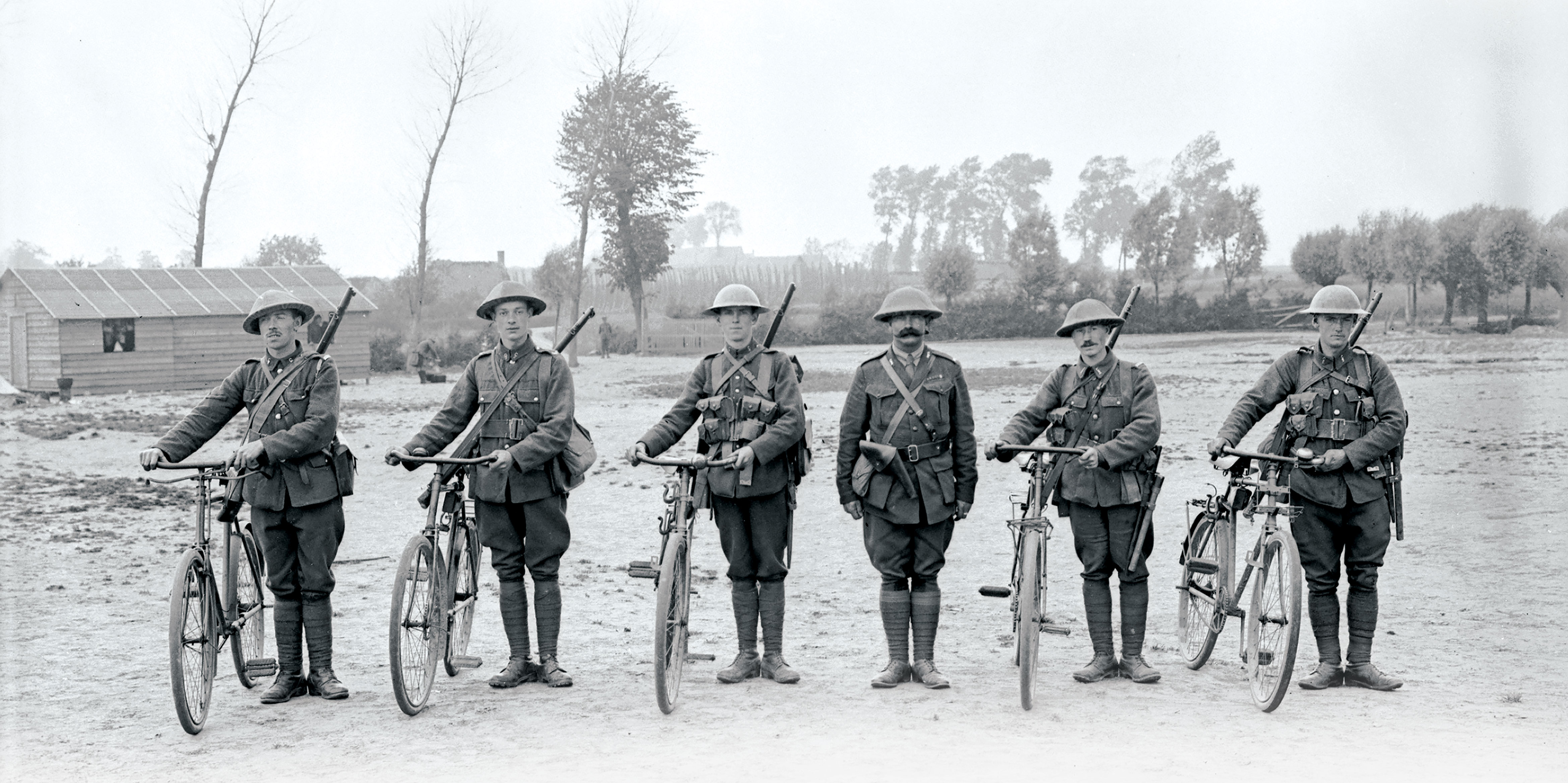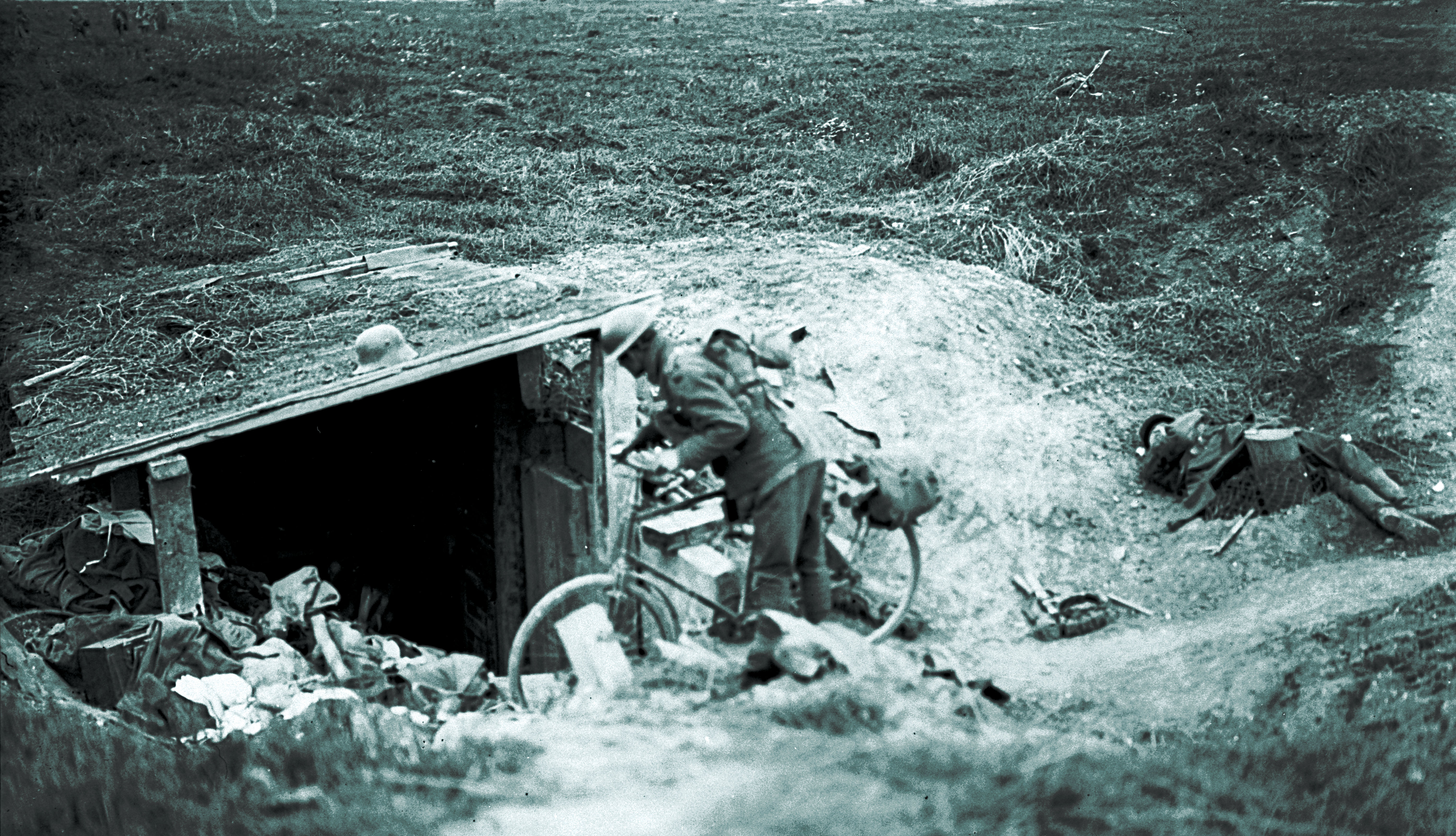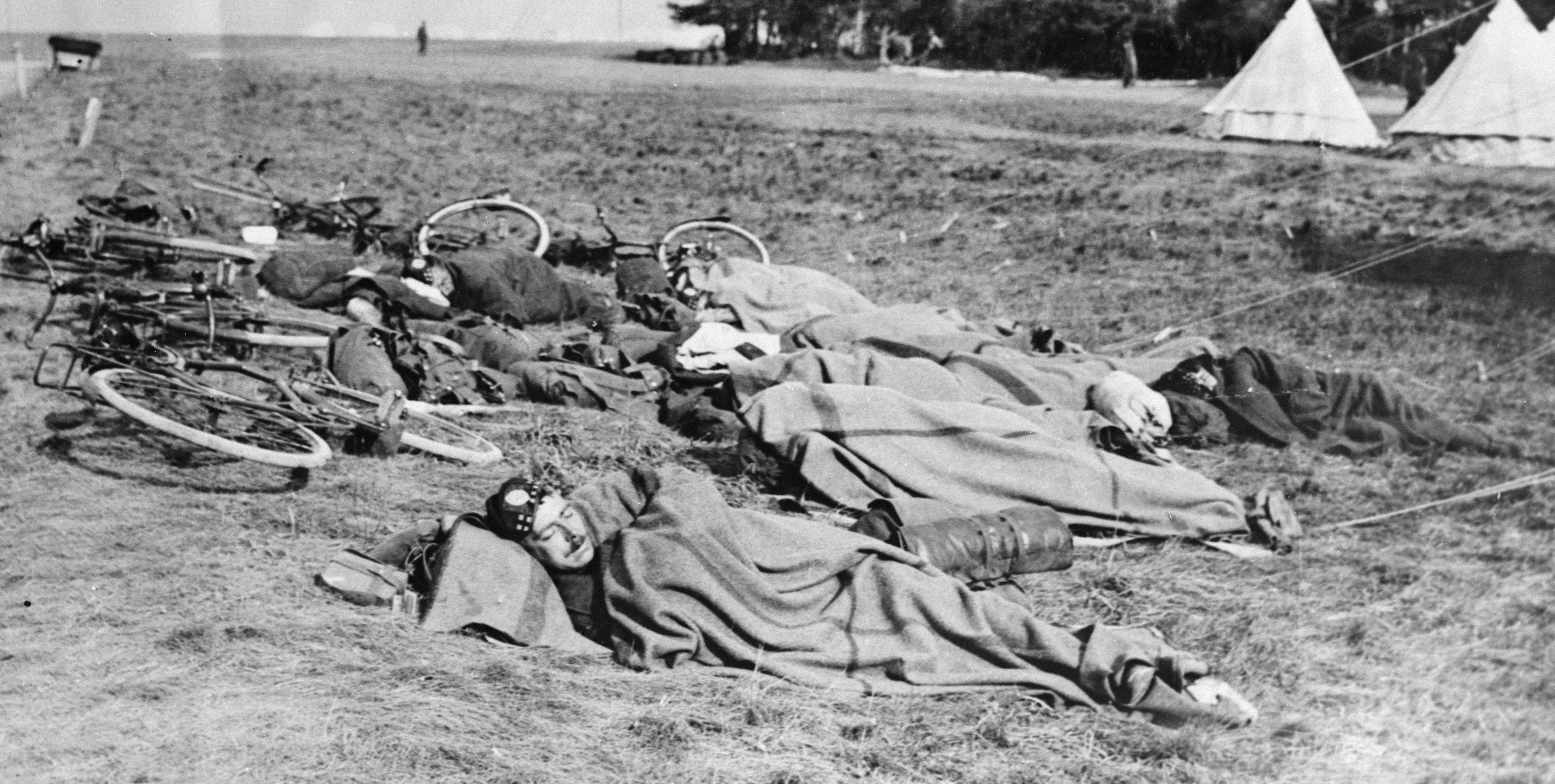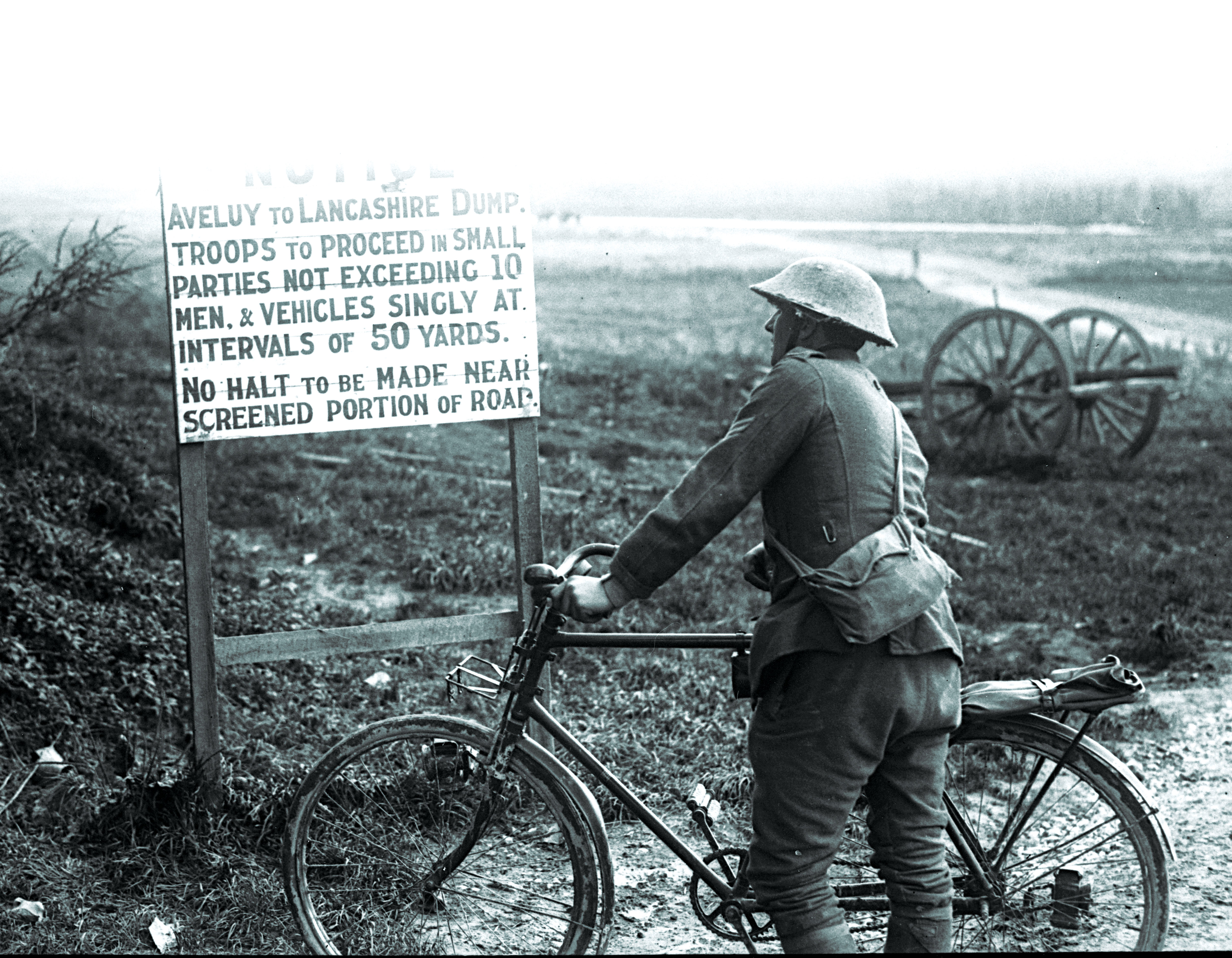
Cyclists with the Canadian Expeditionary Force pose near their rest billets after the fighting at Sanctuary Wood east of Ypres, Belgium, in June 1916. [Henry Edward Knobel/LAC/PA-000385]

Twenty-eight young men stood at attention while posing for a portrait on the steps of the British Columbia Parliament Buildings in Victoria on Dec. 7, 1915. They were about to leave to start their training—not for the cavalry, as might be expected by the presence of their commander, Lieutenant George Edward Sellers, a 32-year-old former Vancouver realtor with militia experience in the 1st Regiment, British Columbia Horse.
No, they were to be a different sort of mounted troops, part of a force that would play an important role in the success of the Hundred Days Offensive, taking on some of the most dangerous work ahead of the front lines at the end of the First World War.
They were to join the Canadian Corps Cyclist Battalion.
The bicycle boom of the late 1800s was not lost on military planners. Bikes could carry more equipment and travel farther in a day than soldiers on foot, and be deployed quickly. Bicycles were also perfect for intelligence work, travelling silently, following narrow tracks, light enough to carry over obstacles, less visible than a horse, quieter than a motorcycle.
All sides in the First World War took advantage of Europe’s paved roads, putting the smallest and cheapest of wheeled vehicles to good use. Britain and its dominions, France and Belgium each fielded more than 100,000 cyclists. Italy provided folding bicycles to some of their Bersaglieri mobile infantry. Germany had about 150,000 in 36 companies of bicycle infantry and bicycle battalions attached to every cavalry division.
More than 1,100 men from all over Canada volunteered to train as cyclists. When they were first seen by infantry “there were stares of amazement, usually followed by some ribald remarks such as ‘Why don’t you get a horse’…together with many other impertinent and unprintable sayings,” wrote retired captain W.D. Ellis in the preface to Saga of the Cyclists in the Great War 1914-1918, an account of bicyclists’ varied experiences in uniform.
Since cyclists could do many jobs carried out by cavalry, including dispatch, scouting and reconnaissance, bicycle units were often attached to, if not welcomed by, cavalry regiments. Cavalry regiments did not want their beloved horses supplanted by machines. But unlike the six million horses that served in the war, bicycles did not have to be fed, groomed or cleaned up after. They were also smaller and less valuable targets than horses, and no one had to be assigned to look after them when their riders dismounted for battle.

A Canadian cyclist approaches a German dugout during the advance east of Arras, France, in 1918. [DND/LAC/PA-003071]
Bicycles could also haul plenty of freight—a bike could weigh more than 40 kilograms loaded with gear, including repair tools, spare parts, kit, rations and weapons. Some had handlebar and frame mounts for portable machine guns. Since they did not have to carry the load themselves, cyclists tended to collect a lot of personal stuff as well.
“Prior to any long move, a good deal of this was jettisoned,” an unidentified cyclist recalled in Saga. “One was always aware of a heavy kit on the long hills.”
Trusty two-wheeled steeds used by Canadians were built by Canada Cycle and Motor Company (CCM), Planet Bicycle Company and Birmingham Small Arms Company (BSA).
Ninety-three members of the 1st Canadian Divisional Cyclist Company, part of the 1st Canadian Divisional Mounted Troops, were drawn from the first recruits who began gathering at Valcartier, Que., in the fall of 1914. They had little time and few bicycles on which to train before leaving for England. They joined other Canadians on the soggy grounds of the Salisbury Plain military training area, and went to France in February 1915. Formed in October 1914, the 2nd Divisional Cyclist Company trained in England while the 1st supported the trench warfare at the front.
Cyclists had to be in top physical condition and be trained in infantry and reconnaissance—“one of his most important duties,” said the 1917 training manual. Many cyclist trainers were former members of the Corps of Guides, precursor to the intelligence service. The cyclists learned bayonet fighting, bombing, signals, map-reading, range-finding and how to fire a lightweight Lewis machine gun. They controlled traffic, carried dispatches, guarded prisoners, bore stretchers and buried bodies.
“We were not yet doing any actual fighting ourselves,” reported one cyclist, “but we were in the thick of it most of the time and suffered many casualties.”

Cyclists and their rides (right) keep a low profile while catching a few well-earned winks. [DND/LAC/PA-004976]
The Germans attacked with chlorine gas for the first time at Ypres, Belgium, on April 22, 1915. Canadian cyclists were part of a counterattack that stopped the German advance.
“We had to push our bikes along the ditches and I won’t forget the gas,” recalled another cyclist in Saga. “Tying a wet sock over my mouth and nose helped a little. We had no gas masks or steel helmets in those days.”
The 2nd Company trained until September and then was sent to the front. The 3rd formed in October 1915 and deployed to France in March 1916. The three were amalgamated into the Canadian Corps Cyclist Battalion in May 1916. The 4th and 5th companies, formed in February and April 1916, were broken up and reassigned, most to infantry and machine-gun units.
“We might claim to have leavened the whole Canadian Corps!” said a cyclist in Saga. Cyclist badges were later seen on caps worn by men in infantry, artillery, machine-gun, engineer, pioneer and railway brigades. “Our ranks were plundered from the very beginning,” said Ken Pettis, quoted in Riding into Battle: Canadian Cyclists in the Great War.
When the 4th Company was transferred to the 74th Battalion, a guard of honour, pallbearers and mourners marked the occasion, ceremoniously burying a broken bicycle at Bramshott Camp in Hampshire to the chant: “Ashes to ashes, dust to dust, if the 74th doesn’t bugger us, the Kaiser must.”

A lucky few dozen from the two disbanded companies were eventually assigned to the Canadian Corps Cyclist Battalion, whose men longed to do the work for which they trained. But most were assigned to support those in the trenches until the cyclists came into their own at the end of the war, when the stalemate of trench warfare broke and armies began to move more than a few metres at a time. The new cyclist battalion began training in August 1916.
“Ever-optimistic general staff wanted to have us all ready for the breakthrough to Berlin,” one cyclist recalled in Saga. Instead, they ended up carrying ammunition and supplies, working in digging parties, bearing stretchers and burying dead at the Battle of the Somme.
“Our first experience of ‘cyclists’ work’ in France was wielding pick and shovel, digging saps and machine-gun emplacements,” recalled a Saga contributor. Cyclists were assigned to help dig the tunnel networks at Vimy Ridge that would facilitate stealthy movement, allow explosives to be planted under German tunnels and lines, and connect to large underground chambers left from chalk quarries, used to conceal troops massed to attack. It was “about the most slavish and uncongenial work we had during the whole war,” said the Saga contributor.
Cyclist Dick Warren was assigned to patrol the tunnels, ever mindful of the water-filled craters overhead and the dangers of flooding. He was using a geophone listening device to monitor progress of German tunnellers when he answered a call of nature.
“A terrific rumble of rushing water sounded in my ears and…I figured I was trapped and had bought it. With my eyes almost popping out…, I snatched the plugs from my ears and all was peaceful again.” The rushing stream had been his own, frighteningly amplified.
During the Battle of Vimy Ridge in April 1917, one cyclist company assembled near Mont-Saint-Éloi, France, in hopes of a cavalry breakthrough that never materialized. After the battle, cyclists were assigned to process more than 4,000 German prisoners of war. And then it was back to trench-support duties.
Cyclists put their experience with Lewis guns to good use in the Battle of Hill 70, where some held forward posts until reinforcements could arrive, and others were detailed to anti-aircraft duty.
In the Battle of Passchendaele in July 1917, said a Saga contributor, “we were soon scattered all over the Canadian Corps area at the usual jobs, such as laying light railways, working on prisoner-of-war cages and manning machine-gun posts…. Our Lewis gunners established ack-ack posts up alongside our field artillery.” The posts were crude—with corrugated iron sides and rubber flooring over the ever-present mud. “When sleeping, we pulled another sandbag up over each leg, allowing the mud to cake on and keep our legs warm.”
The mud had another advantage—it swallowed shells, muffling their explosions, as George Blackstock wrote to his mother in May 1915. He had left his bicycle against a tree so he could manoeuvre across a cratered field under shellfire to deliver a message to an infantry general.
“The big shells…usually have a very local effect as they go well into the earth before bursting, and go straight up throwing mud and pieces of iron,” wrote Blackstock. “They are really far more terrifying than harmful, unless you are within three yards of them.”

A Canadian cyclist considers how to proceed over embattled roads near Albert, France, in October 1917. [DND/LAC/PA-003709]
Germany’s offensive in March 1918 broke through the Allies’ southern lines. Brigadier-General Raymond Brutinel’s mobile machine-gun units rushed in to help hold the line. The units moved quickly to where they were needed, rushing to fill gaps, providing cover for attacks, reinforcing infantry lines, protecting the flank, delivering ammunition.
Their effectiveness led to the creation of the Canadian Independent Force (CIF), made up of two brigades of motor machine guns, armoured cars, trench mortars, some cavalry and the Canadian Corps Cyclist Battalion—all under Brutinel’s command. It was called Brutinel’s Brigade.
“The cyclists were an asset to Brutinel’s force,” wrote Captain C.J.P. Anderson in his essay Amiens to Mons: The Cyclists in Canada’s Hundred Days. “The backbone of the CIF was the 1st and 2nd Canadian Motor Machinegun Brigades and the Canadian Corps Cyclist Battalion, which operated as an ad hoc battlegroup together with other supporting [mobile] troops.”
Cyclists were part of a subterfuge to conceal preparations for the Battle of Amiens in August 1918, when they truly came into their own. They could finally use the skills in which they’d been trained.
The deception began by leaking word that the Canadians were going back to the Ypres Salient, thus deking out the Germans. Riding by dark and lying low by day, the cyclists surreptitiously moved to the front at Amiens, France, arriving at 6 a.m. on Aug 2.
“The battalion covered 57 kilometres in pitch darkness…a real test of stamina and discipline,” wrote Ellis.

General Arthur Currie’s plan was to breach German lines with a heavy artillery attack, a barrage that would roll through the German outposts and trenches, followed by infantry supported by tanks. Brutinel’s Brigade, including cyclists, would then push forward to maintain contact with the enemy, seize ground if possible, and hold it until the infantry caught up.
“We started forward at 8 a.m…and passed through the leading infantry by 10,” reported cyclist Lance-Corporal Alan Macnab, whose unit was assigned to nip at the heels of retreating Germans so they wouldn’t have a chance to dig in and mount a counterattack. “We chased Fritz…all day and finally ran into his reserves about 5 p.m.” The infantry caught up to Macnab’s unit an hour later, but were unable, even with the help of eight tanks, seven of which were lost, to push the Germans farther that day.
The following day, Macnab’s unit was hit by friendly fire at the point where French and Canadian troops abutted. “Halfway to our objective,” he recalled, “the French dropped a barrage of 75 mm shells on us and the French infantry advanced on us with fixed bayonets.” Two cyclists were wounded before the misunderstanding was sorted out.
Protecting the left flank of the Canadian Corps, the cyclists “left their wheels near Monchy and did a spot of infantry work in the line near the Scarpe River,” capturing three enemy trenches under heavy artillery fire.
By Aug. 20, the Canadians had advanced more than 20 kilometres, capturing more than 9,000 prisoners and a slew of field guns, mortars and machine guns, and liberating a number of villages.
“Brutinel’s Brigade…advanced the line nearly one thousand yards,” by Aug. 29, reports the official history of the Canadian Expeditionary Force, “with the Canadian Corps Cyclist Battalion establishing posts right up to the Scarpe. The Canadian front was considerably shortened.”
Now that the war was mobile, the key to victory was to keep moving.
With the success of Amiens behind them, the Allies intended to continue driving the Germans northward, dislodge them from their trenches, break the Drocourt-Quéant Line, cripple them by capturing the transportation hub at Cambrai, and sweep them right out of France. But there were two large obstacles: the heavily fortified D-Q Line and the Canal du Nord.
Cycle platoons were assigned to each of the divisions in the attack on the D-Q Line, and Brutinel’s Brigade reassembled on Aug. 30 with orders to race toward Cambrai, seize bridges before retreating Germans had a chance to destroy them, and establish bridgeheads that would allow the Allies to keep up the pace.
Just before noon on Sept. 2, as Canadian Corps and British troops were slogging it out at the stoutly defended D-Q Line, a CIF unit, including a cyclist platoon, raced forward on the Arras-Cambrai road. Within a quarter hour, the unit was pinned down by shells and machine guns. Sellers was in a group killed instantly by a shell. (He is buried at the Tigris Lane Cemetery in Wancourt, France.) Two other CIF units met much the same fate. Brutinel’s Brigade was withdrawn at midnight. German forces did pull back. And they did destroy the bridges over the Canal du Nord.
The CIF failed to achieve its objectives, said Brutinel, because it was “hastily put together only 24 hours prior to zero and was not properly welded,” wrote Shane Schreiber in Shock Army of the British Empire.
In Riding into Battle, Brutinel is quoted as saying to Currie that if the CIF were to train together in a permanent force, they could “learn their possibilities and limitations, acquire mutual confidence and unity of purpose.” Currie granted Brutinel’s wish on Sept. 19 and the unit became a permanent force.
From that point on, cyclists often rode ahead of the front lines, assigned to reconnaissance, to seize bridges and to hold bridgeheads. They were also frequently ordered to park their wheels and bolster infantry ranks.

The Allies’ momentum was building, but more tough fighting lay ahead.
At a demolished railway bridge near Iwuy in the push to Cambrai on Oct. 1, “we arrived at a sunken road where a gun crew…had got into a bad spot,” recalled cyclist Bill Mennill. A report was sent to headquarters and the unit settled in across the road from the gun crew. “Over the ridge to our left came a troop of the Canadian Light Horse at full gallop.” Straight into machine-gun fire. “Horses rearing, plunging and dying…they were soon halted.”
More than 60 horses were killed, says the regiment’s diary, but riders suffered only light casualties. The survivors dug in. The cavalry was followed by the 19th Infantry Battalion, which also dug in. The Canadians fired at the enemy “in a criss-cross manner” with Vickers and Lewis guns, rifles and grenades. Mennill was hit and “retired from active duty,” he wryly reported. He and other walking wounded made their way to a dressing station nearly nine kilometres away.
Meanwhile, nearby bicycle platoons were sent to help No. 5 Cyclist Platoon, which was impeded by German artillery.
“By the time we started through [Naves], the main street was a shambles of shell holes, bricks, telephone poles and wire” which tangled in some spokes, recalled Macnab. Shells were bursting around them. “It was a case of riding through, ‘hell for leather and the devil take the hindmost.’”
When they arrived at the bridge, “we left our cycles and continued on foot,” fording the shallow river. They found the sunken road and were themselves pinned down by machine-gun fire. About one third of the cyclists were wounded or killed before the German machine gunners were taken out of action.
After being relieved, the weary platoon members returned to their bicycles and backpacks to find many had been riddled with shrapnel.
“I said goodbye to my trusty old Planet Junior Cycle, which had been issued to me in the spring of 1915 in Toronto, and which I had babied and scrounged parts for,” recalled Macnab. “It was cut in two.”

Cyclists training for scout duty pedal through St. Catharines, Ont., in October 1915. [John Boyd/LAC/PA-071630]
Cyclists often found themselves in the vanguard at this late stage of the war.
“The role of the Cyclists during the [Cambrai] offensive was dangerous,” wrote Anderson. “Riding a bicycle along country lanes in front of friendly lines, often by cover of darkness, one must have felt very exposed. Advancing as silently as possible toward an undetermined front, awaiting contact, must have taken both sinews and nerves of steel.”
Cambrai was liberated on Oct. 11, and as the Germans retreated, the CIF became pursuit troops, doing “perhaps their most telling work,” said Macnab.
As the Germans abandoned their positions, usually stealthily at night, they deliberately impeded pursuit by destroying bridges and roads and manipulating water in canals. Allied forces tried to keep in constant contact to prevent that from happening.
“The mobility and speed of [the CIF] proved more effective at maintaining contact with the enemy, but they remained too vulnerable to the machine-gun fire,” said historian Shreiber in Shock Army.
Cyclists kept tabs on the enemy, cleared machine-gun nests before infantry arrived, protected engineers building bridges, and searched roads and buildings for booby traps. And they were nearly mobbed by civilians in liberated villages.
“Being out in advance most of the time, we never knew when we were going to run into trouble, and lost quite a few men,” recalled Macnab. “Sometimes it would be snipers; sometimes machine guns; sometimes field artillery…firing directly at us from positions in the open.”
Canadian Major-General Sir David Watson praised Brutinel’s Brigade, singling out its cyclists for “excellent patrol duties as well as carrying dispatches and securing information regarding enemy movements and positions of our own troops.”
By the end of October, the Canadian Corps had fought to Valenciennes, where it faced five heavily fortified German divisions. Cyclists were the first into the town.
All the bridges had been blown, but a cyclist company crossed a canal, established a bridgehead, and proceeded into the town to clear machine-gun and sniper nests. They were soon joined by infantry, their advance supported by a creeping barrage and reconnaissance reports from cyclist patrols in the town. By 9 a.m. on Nov. 2, cyclists reported to headquarters that Valenciennes was secure.
Mons, Belgium, was the next objective. But the retreating Germans were putting up a stiff fight, aided by topography and weather.
“The countryside…into Belgium had many more villages, deeper valleys and rivers, and densely treed expanses. [Roads were] made largely impassable by large shell craters,” wrote Ted Glenn in Riding into Battle.
“The problem of maintaining the pursuit, already complicated by German demolition, ever-lengthening supply lines and inadequate communications, was intensified by bad weather,” said the CEF official history. As one village was occupied, Canadians were held up by machine-gun fire from the next. It rained all but one of the next 10 days. “The muddy roads slowed cyclists and mounted orderlies.”
Civilians kept mistakenly cutting the Canadian telephone lines, leading some cyclists to be tapped for communication duties. Others were ordered to harass the enemy in retreat as Canadian and British troops battled to liberate Mons. It was all over on Nov. 11.
“We then pulled back…to await the next move, up to the Rhine,” reported Macnab.
The cyclists headed to Germany with two Canadian divisions on Nov. 17 and 18, to be used for communications, sentry duty and guarding prisoners. Cyclist Garnet W. Durham of Regina is reported to have been the first Canadian to cross the bridge to Bonn.

“In the last two years of the war, no battalion had a more adventurous life than the cyclists,” said an April 1919 article in the Toronto Star, quoted in Riding into Battle.
The casualty count for the corps of 1,138 was 261 killed or wounded; 73 were decorated for valour. Early in 1919, the cyclists started their journey home.
A memorial obelisk to cyclists was erected in England, but Canadian cyclists “never sought formal recognition from the Government of Canada for their collective sacrifice during the war, and instead thrived upon their comradeship,” wrote Anderson. They formed the Canadian Corps Cyclist Battalion Association in 1934.
At a reunion in 1937, a bottle of Pol Roger champagne was put aside to be saved for the last two survivors of the corps, so they could toast their comrades. At each reunion, survivors would toast “To the last two cyclists.” In 1992, William Ellis, 96, and Billy Richardson, 98, opened that bottle, shared reminiscences and toasted their comrades.
Four years later, Ellis was the last member of the cycle corps to die. With him went the lived memory of Canada’s cavalry on wheels.
Advertisement





















